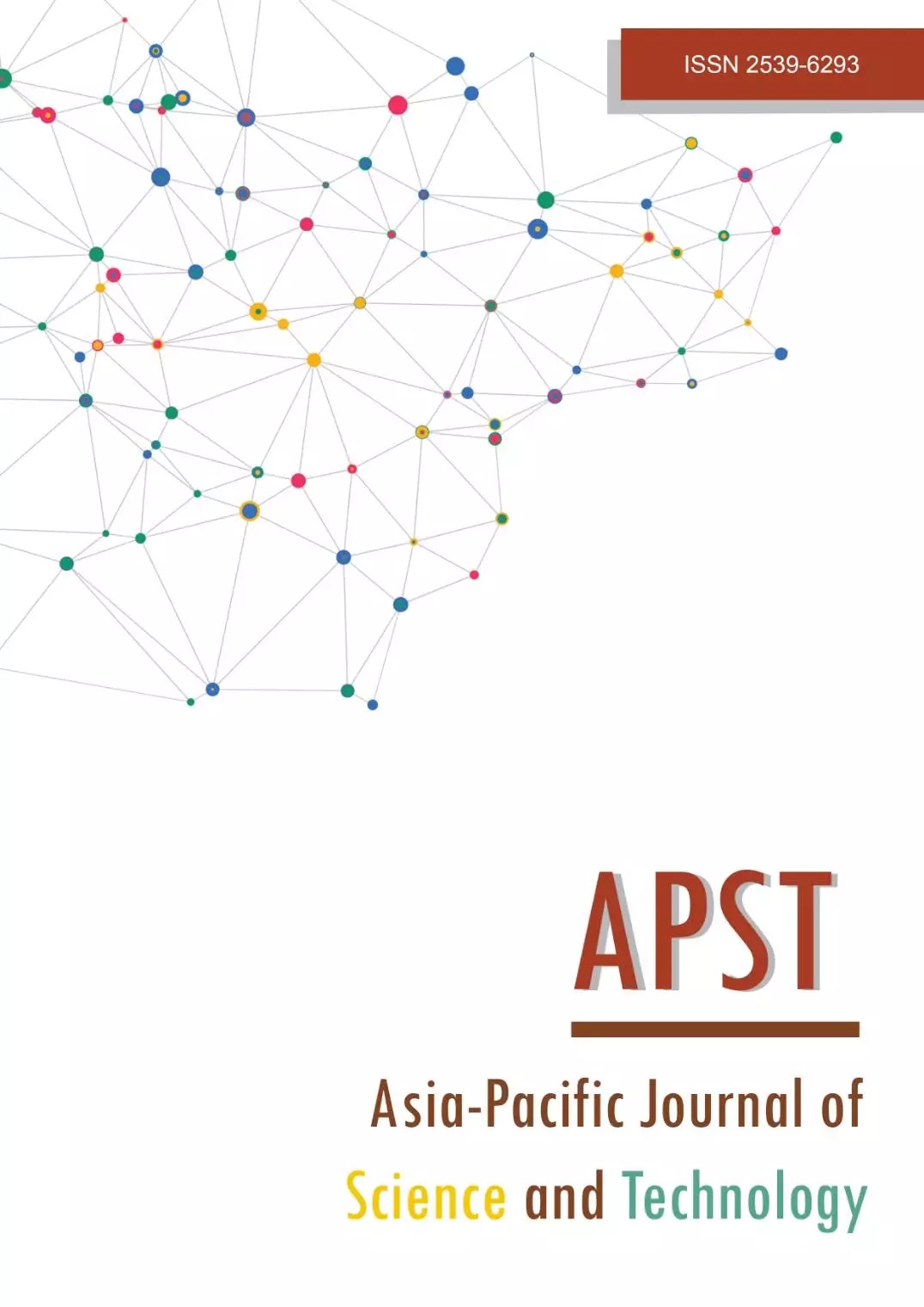Phytochemical screening, total phenolic, flavonoid and alkaloid contents, cytotoxicity, and antioxidant activities of Capparis monantha, Jacobs extracts
Main Article Content
Abstract
Capparis monantha Jacobs is a medicinal plant that is found on the coast of Thailand. These herbal medicines are used by the local people to cure hemorrhoids and as an anticancer treatment. The goal of the current examination was to analyze the phytochemical constituents, total phenolic, total flavonoid, total alkaloid contents, antioxidant activities, and anticancer properties against three cancer cell lines (KB cell line, MCF-7 cell line, and small NCI-H187 cell line) in the stem of C. monantha Jacobs. The C. monantha Jacob’s powder was extracted with hexane, dichloromethane, acetone, and methanol, by using a maceration method. The increasing polarity of the organic solvent was used to fractionate the extracted residue. The qualitative phytochemical screening reveals all extracts containing tannin and phenolic, flavonoid, triterpenoid, and alkaloid. The total phenolic was carried out using the Folin-Ciocalteau method. The highest total phenolic, total flavonoid, and total alkaloid contents were found in acetone extract (447.3 mg GAE (Gallic Acid Equivalent)/g extract), hexane extract (579.2 mg QE (Quercetin Equivalents)/g extract), and methanol extracts (13.80 mg AE (Aescin Equivalents)/g extract), respectively. The antioxidant activity is high in acetone extract. Cytotoxicity measured by Resazurin microplate assay of all extract fraction at 50 mg/mL against three cancer cell lines (KB cell line, MCF-7 cell line, and NCI-H187 cell line) were found to less than 50% inhibited cancer growth. According to the literature, it is most likely that this is the first report on phytochemical screening, total phenolic, flavonoid, and alkaloid contents, cytotoxicity, and antioxidant activities of C. monantha Jacobs.
Article Details

This work is licensed under a Creative Commons Attribution-NonCommercial-NoDerivatives 4.0 International License.
References
Valko M, Rhodes CJ, Moncol J, Izakovic M, Mazur M. Free radicals, metals and antioxidants in oxidative stress-induced cancer. Chem Biol Interact. 2006;160:1-40.
Said O, Khalil K, Fulder S, Azaizeh H. Ethnopharmacological survey of medicinal herbs in Israel, the Golan Heights and the West Bank region. J Ethnopharmacol. 2002;83(3):251-265.
Noori S. An overview of oxidative stress and antioxidant defensive system. Open Access Sci Rep. 2012;1(8):1-9.
Suwansin N. Flora in Pongsalood forest at Phetchaburi province [thesis]. Phetchaburi: Phetchaburi Rajabhat University; 2010.
Harborne JB. Phytochemical Methods. A guide to modern techniques of plant analysis. 3rd ed. London: Chapman & Hall; 1998.
Singleton VL, Rossi JA. Colorimetry of total phenolics with phosphomolybdic-phosphotungstic acid reagents. Am J Enol Vitic. 1965;16:144-158.
Zhishen J, Mengcheng T, Jianming W. Determination of flavonoid contents in mulberry and their scavenging effects on superoxide radicals. Food Chem. 1999;6:555-559
Fazel S, Hamidreza M, Rouhollah G, Mohammadreza V. Spectrophotometric determination of total alkaloids in some Iranian medicinal plants. J Appl Hortic. 2010;12(1):69-70.
O’Brien J, Wilson I, Orton T, Pognan F. Investigation of the Alamar Blue (resazurin) fluorescent dye for the assessment of mammalian cell cytotoxicity. Eur J Biochem. 2000;267(17):5421-5426.
Karagozler AAB, Erdag YC, Uygun DA. Antioxidant activity and proline content of leaf extract from Dorystoechas hastata. Food Chem. 2008;111:400-407.
Dangarembizi R, Erlwanger KH, Moyo D, Chivandi E. Phytochemistry, pharmacology and ethnomedicinal uses of Ficus thonningii (Blume moraceae): a review. Afr Journal Tradit Complement Altern Med. 2013;10(2):203-212.
Rathore K, Singh VK, Jain P, Rao SP, Ahmed Z, Singh VD. In-vitro and in-vivo antiadipogenic, hypolipidemic, and antidiabetic activity of Diospyros melanoxylon (Roxb). J Ethnopharmacol. 2014;155:1171-1176.
Teh SS, Bekhit AED, Birch J. Antioxidative polyphenols from defatted oilseed cakes: effect of solvent. Antioxidants. 2014;3:67-80.
Okuda T, Ito H. Tannins of constant structure in medicinal and food plants-hydrolysable tannins and polyphenol related to tannin. Molecules. 2011;16:2191-2217.
Ujwala W, Vijender S, Mohammad A. In-vitro antioxidant activity of isolated tannins of alcoholic extract of dried leaves of Phyllanthus Amarusschonn Thonn. Int J Drug Dev Res. 2012;4(1):274-285.
Ashok PK, Upadhyaya K. Tannins are astringent. J Pharmacogn Phytochem. 2012;1(3):45-50.
Xi M, Hai C, Tang H, Wen A, Chen H, Liu R, et al. Antioxidant and antiglycation properties of triterpenoid saponins from Aralia taibaiensis traditionally used for treating diabetes mellitus. Redox Rep.2010;15(1):20-28.
Tan MJ, Ye JM, Turner N, Behrens CH, Ke CQ, Tang CP, et al. Antidiabetic activities of triterpenoids isolated from bitter melon associated with activation of the AMPK pathway. Chem Biol. 2008;15:263-273.
Pietta PG. Flavonoids as antioxidants. J Nat Prod. 2000;63:1035-1042.
Ren W, Qiao Z, Wang H, Zhu L, Zhang L. Flavonoids: promising anticancer agents. Med Res Rev. 2003;23(4):519-534.
Ozcelik B, Orhan DD, Ozgen D, Ergun F. Antimicrobial activity of flavonoids against extended-spectrum β-lactamase (ESβL)-producing Klebsiella pneumoniae. Trop J Pharm Res. 2008;7(4):1151-1157.
Bousselessela H, Yahia M, Mahboubi A, Benbia S, Massinissa Y. Antioxidant and antibacterial activity of alkaloids and terpenes extracts from Euphorbia granulate. Int J Sci Res Innov. 2013;7(3):166 -169.
Tiong SH, Looi CY, Hazni H, Arya A, Paydar M, Wong WF, et al. Antidiabetic and antioxidant properties of alkaloids from Catharanthus roseus (L.) G. Don. Molecules. 2013;18:9770-9784.
Souto AL, Tavares JF, Silva MS, Diniz MF, Filho APF, Filho JMB. Anti-inflammatory activity of alkaloids: an update from 2000 to 2010. Molecules. 2011;16:8515-8534.
Rajhi I, Dhia BMT, Abderrabba M, Hadda QI, Ayadi S. Phytochemical screening, in vitro antioxidant and antibacterial activities of methanolic extracts of Capparis spinosa L. different parts from Tunisia. J Mater Environ Sci. 2019;10(3):234-243.
Panche AN, Diwan AD, Chandra SR. Flavonoids: an overview. J Nutr Sci. 2016;5(e47): 1-15.
Fu XP, Aisa HA, Abdurahim M, Yili A, Aripova SF, Tashkhodzhaev B. Chemical composition of Capparis spinosa fruit. Chem Nat Compd. 2007;43(2):181-183.
Kalita P, Barman TK, Pal TK, Kalita R. Estimation of total flavonoids content (tfc) and antioxidant activities of methanolic whole plant extract of Biophytum sensitivum Linn. J Drug Deliv Ther. 2013;3(4):33-37.
Wang Y, Huang S, Shao S, Qian L, Xu P. Studies on bioactivities of tea (Camellia sinensis L.) fruit peel extracts: antioxidant activity and inhibitory potential against α-glucosidase and α-amylase in vitro. Ind Crops Prod. 2012;37:520-526.
Arslan I, Celik A. Saponin rich fractions (SRPs) from soapwort show antioxidant and hemolytic activity. In: Dan Y, editor. The 3rd International Conference on Biomedical Engineering and Technology; 2013 May 19-23; Copenhagen, Denmark. Amsterdam: Elsevier; 2013. p.103-108.


